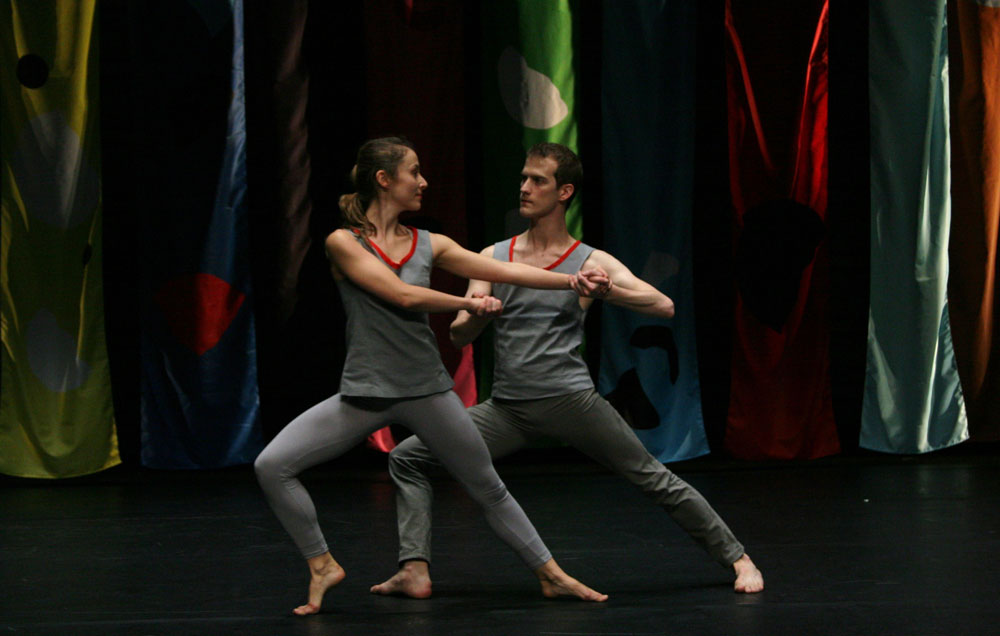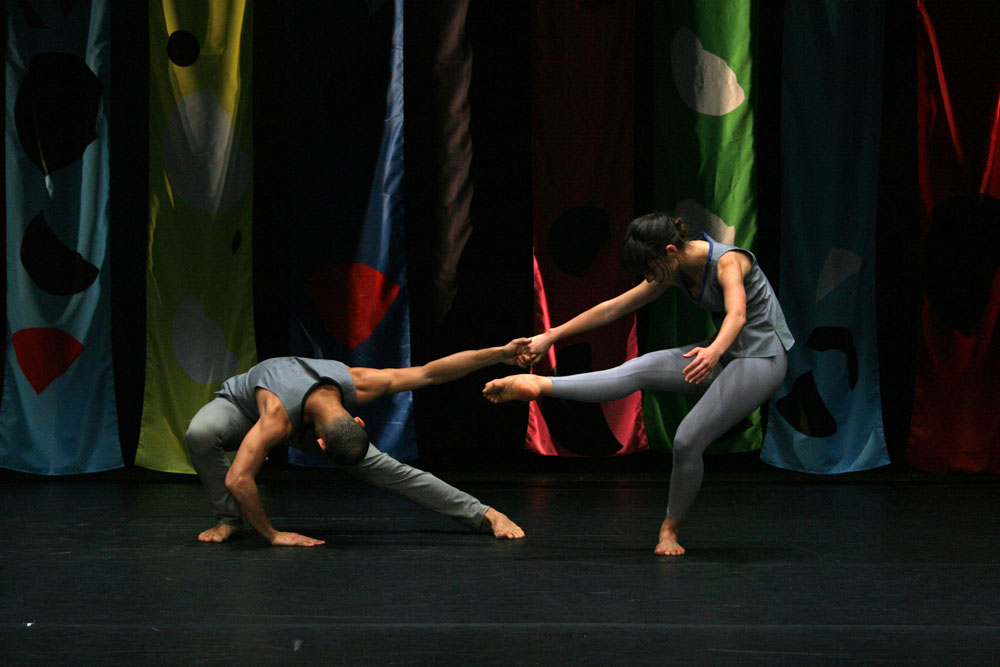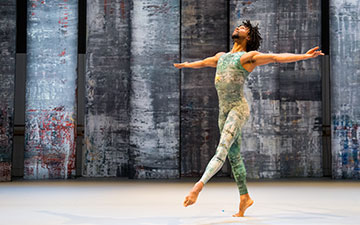
© Patrick Andre. (Click image for larger version)
Compagnie CNDC-Angers / Robert Swinston
Event: Choreography by Merce Cunningham
New York, Joyce Theater
11 March 2015
www.cndc.fr
www.joyce.org
Cunningham, by Way of France
In the final decade of the Merce Cunningham Dance Company’s existence, the dancer Robert Swinston became Merce Cunningham’s right hand man – the official title was “assistant to the choreographer” – , in charge of keeping the repertory in shape and staging revivals. Then, after Cunningham’s death, during the remarkable two-year “Legacy Tour,” Swinston’s role expanded. He became the choreographer’s stand-in, the man responsible for selecting the repertory and putting together the epically-scaled farewell performances at the Park Avenue Armory at the end of 2011. For three nights, selected passages spanning five decades, deftly woven together by Swinston, were performed on platforms scattered around the armory’s vast space. (These compound works, or “Events,” were not a new thing: Cunningham began periodically presenting composites made out of excerpts in 1964.)
Then, in accordance with Cunningham’s directives, the company folded. The dancers dispersed; some are still in New York working with other choreographers. Others are staging Cunningham dances on other companies and schools. Some have settled into teaching. Swinston, however, took a different path: he headed to France, a country that embraced Cunningham long before his compatriots could begin to wrap their heads around this radically abstract, non-musically-based approach to dance. Swinston now directs the Centre National de Danse Contemporaine (CNDC) in Angers, a medieval city in western France, and leads its satellite company, CNDC Angers. In a way, it has become the final outpost of Cunningham’s technique and approach. This week, the ensemble is performing at the Joyce for the first time.

© Patrick Andre. (Click image for larger version)
The eight dancers under Mr. Swinston’s care have had time to absorb the complicated coordination and autonomy that lies at the heart of this style. There’s no music to rely on; the aural environment (here by John King and Gelsey Bell, performed live) is completely independent from the dancing, offering no counts or beats for the dancers to adjust to. In this case, the score consists of vocal manipulations (whispering, humming, breathing) by Ms. Bell and computer-generated drones and violin scrapes by Mr. King. The dancers exist in their own separate space, animated by movement and the collaboration between bodies. The dancers seem well-adjusted to this total independence, as well as to the tilts, bends, falls, and endless relevés – standing on the tips of the toes – that riddle Cunningham’s choreography.
Even more, they flavor the steps with their own personalities, much as the Cunningham company dancers used to. (Only one, Gianni Joseph, goes so far as to “comment” on the action, squinting and raising his eyebrows as if letting the audience in on a private joke.) Fleeting smiles brighten faces at particularly tricky points in the choreography, or during pleasurable passages of partnering. (The dancers seem to greet each other with their eyes.) The stage is animated by a sense of camaraderie, common purpose and mutual awareness.
The dancers’ classical training is evident, as is their understanding of the particular rigors of Cunningham. Mr. Swinston has trained them well. It’s surprising just how classical many of these dances look now, with the benefit of a little hindsight. Much of the partnering – the “Event” is anchored by a series of male-female duets – have much in common with the modernism of Balanchine. Stretched, articulate bodies twisting, tilting and intersecting in unexpected ways, always with a certain air of formality and courtliness. The partners remain at a distance, usually touching at only at one point, the hand, the wrist, shoulder to shoulder, or a forearm beneath the shoulder blades. I was particularly struck by an exit in which a man gently directed a woman offstage: she was bent back so deeply that she couldn’t see where she was headed. Her legs led her, blindly, toward the unknown. It was like end of Balanchine’s “Divertimento from ‘Le Baiser de la Fée,’” taken out of context and stripped of its romanticism. The mystery remained.

© Patrick Andre. (Click image for larger version)
All the dance excerpts included by Swinston in this Event date from before 1992, in other words before Cunningham began using a computer program to amp up his choreographic possibilities. The later works are almost inhuman in their complexity, but these still bear a clear connection to situations from life, animal behavior, art history. At one point, a quartet slowly traversed the stage, holding hands, like a family on an outing; the smallest member skittered here and there, sometimes pausing to embrace one of the others like an excitable child seeking attention. A woman stood in attitude, holding one arm up and the other down, like a religious icon. But the images were fleeting. As always with Cunningham, the feeling of enlightenment comes and goes. The situations are like a series of inexplicable enigmas. As one episode flows into the next, it’s difficult to keep track of what came before, and impossible to know what will come after. It’s an experience both frustrating and engrossing.
For the designs, Swinston selected two French collaborators, Jackie Matisse (visual design) and Michelle Amet (costumes). The costumes were simple and unisex, gray tights to the ankle and silky sleeveless tops the color of fog. (The dancers were barefoot, as usual.) The stage was framed by colorful vertical banners of fabric, animated by a breeze and bathed in shifting light by Augustin Sauldubois. There was something almost naïf about the banners: they looked like cheerful flags at a school “international day” fair. But once set in motion, they added warmth to the dancing, like a lace curtain fluttering over a kitchen window in the afternoon sun. One of the dancers skimmed the fabric as she glided past in swimming steps, giving the fabric an aquatic feel.
It was hard not to think that this is what life might have looked like had Cunningham determined that the company should live on after his death. But, one reminds oneself, there would have been no new works, just revivals and reconfigurations like this “Event.” Swinston is a master builder; the suite has a nice ebb and flow and reveals points of thematic interplay between the dances. It begins well – with each of the dancers walking calmly from the wings and standing in fourth position, facing a different direction–and ends well. But Swinston isn’t Cunningham; he can’t conjure a new Cunningham dance out of thin air. There’s the rub. The dancers, and Swinston, were warmly received by a home crowd happy to revisit a bit of its not-so-distant past.

















You must be logged in to post a comment.